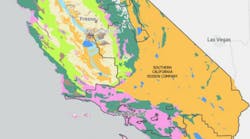Southern California Edison executives are still studying their options for undergrounding power lines at any sort of scale and said Feb. 24 it will be several years before they launch such an initiative.
SCE CEO Steve Powell and Pedro Pizarro, CEO of SCE parent company Edison International Inc., told analysts and investors that covered conductors are their preferred method of eliminating wildfire risks and pointed to lower costs – about $600,000 per mile versus between $1.5 million and $5.5 million per mile for undergrounding – as well as shorter deployment times – 16 to 24 months versus 25 to 36 months for undergrounding – as key factors. Powell added that his team is still studying if undergrounding is the way to go in several higher-risk areas.
“We're evaluating probably hundreds of miles of opportunities for undergrounding that would be at least a few years out,” Powell said during a conference call on the heels of Edison International’s fourth-quarter earnings report, noting that the company has undergrounded only about 10 miles so far. “We still have work to do to figure out how much we could bring those costs down doing them in larger volumes and targeted places where we can manage the cost more effectively.”
SCE last year installed about 1,500 miles of covered conductors, lifting its total work in that area to roughly 2,900 miles. The company leaders’ approach to undergrounding is markedly different from the plan laid out by their peers at Pacific Gas & Electric, who are fleshing out an undergrounding program that will bury 3,600 miles of lines by 2026 and eventually grow that initiative to 10,000 miles. But, Powell and Pizarro also pointed out that the primary vegetation in significant portions of SCE’s service territory is chaparral and desert scrub. PG&E does much more work in heavily forested areas that pose different risk to lines.
Pizarro and Powell, whose teams recently filed an update to SCE’s wildfire mitigation plan, made their comments after Edison International reported a fourth-quarter net profit of $571 million on revenues of more than $3.3 billion. Those numbers were up from $552 million and a little less than $3.2 billion in the same period of 2020. They’re forecasting that the company’s rate base is set to grow an average of 9% annually through 2025, when it is expected to top $49 billion.
Shares of Edison International (Ticker: EIX) rose more than 5% Feb. 25 to $62.35. They have over the past six months gained about 10%.


